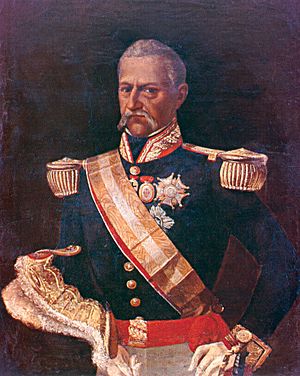Pedro José de Zavala, 7th Marquess of Valleumbroso facts for kids
Quick facts for kids
The Marquis of Valleumbroso
|
|
|---|---|

Portrait of the Marquis of Valleumbroso
|
|
| Personal details | |
| Born |
Pedro José de Zavala y Bravo del Ribero
10 August 1779 Lima, Viceroyalty of Peru, Spain |
| Died | 20 June 1850 (aged 70) Lima, Peru |
| Spouses | Grimanesa de la Puente y Bravo de Lagunas, Marquise of la Puente |
| Military service | |
| Allegiance | Spain |
| Branch/service | Spanish Army |
| Rank | Field marshall |
Pedro José de Zavala y Bravo de Ribero, the 7th Marquess of San Lorenzo del Valleumbroso, was a Spanish-Peruvian nobleman and soldier. He was born on May 21, 1779, and passed away on January 20, 1850. He held important titles like OIC and KOC.
Contents
Pedro's Life and Military Career
Pedro Zavala was born in Lima, which was then part of the Viceroyalty of Peru. This was a Spanish colony in South America. His family was one of the most important and well-known in the area. His father was Pedro Nolasco de Zavala y Pardo de Figueroa, who was the 6th Marquess of Valleumbroso.
Joining the Army
Pedro began his military journey in 1787. He joined the Spanish Army as a cadet in the 3rd Regiment of the Dragoons Guards of Lima. A cadet is like a student training to become an officer.
In 1790, he became an ensign in the Cavalry Regiment of the Nobility. An ensign is a junior officer rank. Later, in 1797, he moved to the Company of Dragoons of Queen María Luisa. By 1799, he was back with the Dragoons Guards of Lima. He was promoted to captain in 1804.
Rising Through the Ranks
In 1812, Zavala created the King's Cavalry Company. He was then promoted to the rank of lieutenant colonel in the Royal Army. This meant he was becoming a more senior officer. In 1819, he became a colonel, leading the Battalion of Spaniards.
During the Peruvian War of Independence, which was a fight for Peru to become independent from Spain, Pedro Zavala played a role. He helped defend the ports of Callao, Chancay, and Ancón in 1820 and 1821.
He supported a change in leadership called the Aznapuquio mutiny. This event removed the old Viceroy (the Spanish ruler) from power. The new Viceroy, José de la Serna, asked Zavala to travel to Spain. His mission was to tell the King about the situation in Peru. However, his journey was stopped when his ship was captured by an Argentinian warship in June 1821.
Life in Spain
After this, Pedro Zavala moved to Madrid, Spain. He joined different army units there. In 1822, he received a special award called the Grand Cross of the Order of Isabella the Catholic. This was for his service in Peru.
In 1824, King Fernando VII appointed him as a "Gentilhombre de cámara con ejercicio." This was an important position in the royal court. Zavala continued to rise in the military. He became a brigadier in 1826 and a Field marshall in 1836. These are very high ranks in the army.
The next year, in 1837, he became the second lieutenant of the Guard of Halberdiers. This was the Queen's personal guard. He commanded this guard from 1841 to 1843.
In 1849, Pedro Zavala returned to Peru. He passed away there the following year.
Pedro's Family
In 1804, Pedro Zavala married Grimanesa de la Puente y Bravo. She was also a noblewoman with several titles, including the 4th Marchioness of Torreblanca. Together, they had twelve children. Some of their notable children include:
- Pedro de Zavala y la Puente, who became a Peruvian soldier.
- Juan de Zavala, 1st Marquess of Sierra Bullones, who later became the Prime Minister of Spain.
- Toribio de Zavala y la Puente, a colonel in the Peruvian Army.
- José de Zavala y la Puente, a colonel and prefect of Trujillo.
- Grimanesa de Zavala y la Puente, who married José Gregorio Paz Soldán.
- Andrés de Zavala y la Puente, who was the stepfather of Manuel González Prada.
- Ana de Zavala y la Puente, who became the 1st Marchioness of La Puente.
See also
 In Spanish: Pedro José de Zavala y Bravo del Ribero para niños
In Spanish: Pedro José de Zavala y Bravo del Ribero para niños

